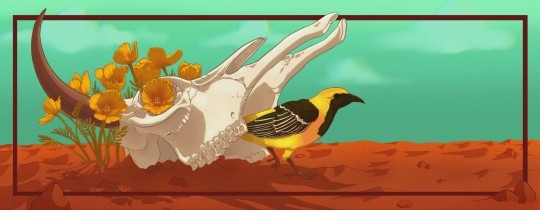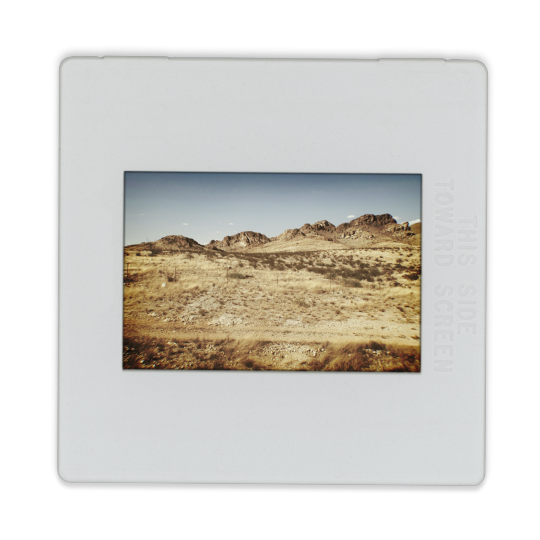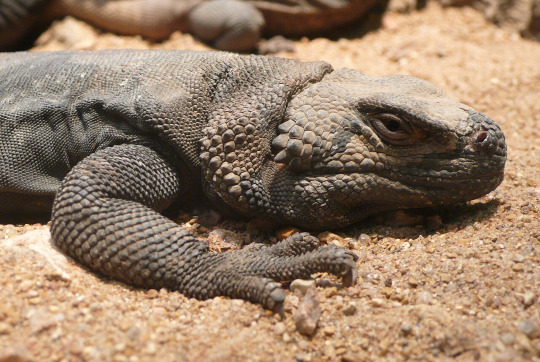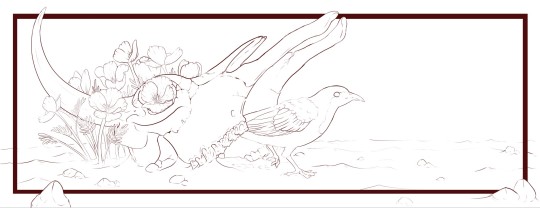#southwestern united states
Explore tagged Tumblr posts
Note
Gila monster?


#southwestern united states#sonora#venomous lizard#gila monster#near threatened#lizard#lizards#herpblr#reptile#reptiles#reptilia#squamata#helodermatidae#heloderma#animal polls#poll blog#my polls#animals#polls#tumblr polls
73 notes
·
View notes
Text



My contest submission for the They Draw gallery "Southwest Vibes". The concept was based on the Lenormand card "home".
#digital art#illustration#digital art procreate#start to finish#sketch to final#southwestern united states#southwest vibes#southwest#golden poppy#hooded oriole#southwestern bird#lenormand#Lenormand home
115 notes
·
View notes
Text


FILE UNDER: AMERICAN SOUTHWEST, VINTAGE MAGAZINES, LANDSCAPES, NATURE PHOTOGRAPHY, AMERICANA, ETC...
PIC(S) INFO: Spotlight on the cover page to "Arizona Highways" magazine, published in October 1959, prices at $0.40.
EXTRA INFO: "Arizona Highways'" award-winning photography and travel journalism has celebrated the beauty and splendor of Arizona since 1925.
Sources: https://arizonahighways.wordpress.com/2013/10/01/vintage-arizona-highways-cover-october-1959/#comments & eBay.
#Arizona Highways#Arizona Highways magazine#Magazine#Vintage Magazines#Americana#American Style#United States#Arizona#USA#Southwestern United States#1959#1950s#50s#Magazines#American Southwest#Southwest#October Season#Arizona Highways Magazine#Nature photography#Photography#Fall Season#Fifties#Fall#Autumn#Nature#Vintage Style
5 notes
·
View notes
Photo

The sun kisses the rugged peaks of Ventana Canyon, casting a warm glow over the sprawling Tucson landscape below. Majestic saguaros stand tall, guardians of the serene Arizona wilderness.
#Ventana Canyon#Tucson#Arizona#sunset#mountain peaks#saguaro cacti#desert landscape#wilderness#natural beauty#warm glow#rugged terrain#outdoor photography#Southwestern United States#desert sunset#Arizona wilderness
2 notes
·
View notes
Video
HU009376 by manhhai Via Flickr: 2 November, 1965, Arizona, United States --- CF-5 Freedom Fighter aircraft refuel en route to Vietnam. --- Image by © Hulton-Deutsch Collection/CORBIS
#Aircraft#Airplane#Arizona#Boeing KC-135R Stratotanker#Combat aircraft#Fighter plane#Jet plane#Military aircraft#Nobody#North America#Northrop Aircraft Company aircraft#Northrop CF-5 Freedom Fighter#Northrop F-5#Southwestern United States#Support aircraft#Swing-wing aircraft#Transportation#USA#Vehicle#flickr
12 notes
·
View notes
Link
32 notes
·
View notes
Text



2 notes
·
View notes
Text
Reblogging to help increase the sample size!
Okay because I'm genuinely curious, what does everybody call this little guy

Put where you're from in the tags if you want! (general regions only obviously pls don't doxx yourselves)
10K notes
·
View notes
Video
Postcrossing US-10383861 by Gail Anderson Via Flickr: Postcard featuring the famous Route 66 and the state of Texas. Sent to a Postcrossing member in Germany.
#colorful#Postcard#Postcrossing#retro#Amarillo#Texas#United States#Southwestern United States#Route 66#Highway#flickr
0 notes
Text
All the degrees Kevin had acquired, the colleges and universities he had gone to with the fellowships and scholarships he had received, his father had never showed up. But every town had been promising. Every place at first had said, Here you go – You can live here. You can rest here. You can fit. The enormous skies of the Southwest, the shadows that fell over the desert mountains, the innumerable cacti – red-tipped, or yellow-blossomed, or flat-headed – all this had lightened him when he'd first moved to Tucson, taking hikes by himself, then with others from the university. Perhaps Tucson had been his favorite, had he been forced to choose – the stark difference between the open dustiness there and the ragged coastline here.
But as with them all, the same hopeful differences – the tall, hot white glassed buildings of Dallas; the tree-lined streets of Hyde Park in Chicago, with the wooden stairs behind each apartment (he had loved those, especially); the neighborhoods of West Hartford, where it looked like a storybook, the houses, the perfect lawns – they all became places that sooner or later, one way or another, assured him that he didn't, in fact, fit.
When he got his medical degree from Chicago, attending the ceremony only because one of his teachers – a kind woman, who had said it would sadden her to have him not there – he sat beneath the full sun, listening to the president of the university say, in his final words to them, “To love and be loved is the most important thing in life,” causing Kevin to feel an inward fear that grew and spread through him, as though his very soul were tightening. But what a thing to say – the man in his venerable robe, white hair, grandfatherly face – he must've had no idea those words could cause such an exacerbation of the silent dread in Kevin. Even Freud had said, “We must love or we grow ill.” They were spelling it out for him. Every billboard, movie, magazine cover, television ad – it all spelled it out for him. We belong to the world of family and love. And you don't.
New York, the most recent, had held the largest hopes. The subways filed with such a variety of dull colors and edgy-looking people; it relaxed him, the different clothes, the shopping bags, people sleeping or reading or nodding their heads to some earphoned tune; he had loved the subways, and for a while the activities of the hospitals. But his affair with Clara, and the end of it, had caused him to recoil from the place, so that the streets now seemed crowded and tiresome – all the same. Dr. Goldstein he loved, but that was it – everyone else had become tiresome, and he had thought more and more how provincial New Yorkers were, and how they didn't know it.
What he began to want was to see his childhood home – a house he believed, even as he sat in his car now, that he had never once been happy in. And yet, oddly, the fact of its unhappiness seemed to have a hold on him with the sweetness of a remembered love affair. For Kevin had some memories of sweet, brief love affairs – so different from the long-drawn-out mess with Clara – and none measured up to the inner desire, the longing he felt for that place. That house where the sweatshirts and woolen jackets stank like moist salt and musty wood – the smell made him sick, as did the smell of a wood fire, which his father had sometimes made in the fireplace, poking at it in a distracted way. Kevin thought he must be the only person in the country who hated the smell of a wood fire. But the house, the trees tangled with woodbine, the surprise of a lady's slipper in the midst of pine needles, the open leaves of the wild lilies of the valley – he missed it.
He missed his mother.
I've made this awful pilgrimage...I've come back for more...Kevin wished, as he often did, that he had known the poet John Berryman.
— Olive Kitteridge (Elizabeth Strout)
#book quotes#elizabeth strout#olive kitteridge#places#description#travel#belonging#home#family#mothers#returning#fear#love#usa#southwestern united states#arizona#illinois#new york#tucson#chicago#new york city#nature#sky#desert#plants#cacti#trees#flowers#senses#smell
0 notes
Text


This animal was requested!
#southwestern united states#northern mexico#north american reptile#reptile#iguanidae#chuckwalla#squamata#squamates#iguania#animal polls#poll blog#my polls#animals#polls#tumblr polls#lizard#lizards#herpetology#herpblr#reptiblr
56 notes
·
View notes
Text

Line art for a gallery competition! The theme was "Southwest".
I pulled from my Lenormand deck for inspiration and got "house" as the card.
#digital art#illustration#digital art procreate#wip#hooded oriole#southwest#southwest vibes#southwestern united states#mexican poppies#desert flowers#desert flora#desert birds
97 notes
·
View notes
Text

SELLING YOU SOUTHWESTERN TRAVEL DESTINATIONS IN VINTAGE AMERICAN MAGAZINES.
PIC INFO: Spotlight on the cover page to "Arizona Highways" magazine, dated April 1965, "River Trip through Marble and Grand Canyons," published by Arizona Highways Department, Phoenix, Arizona, USA.
EXTRA INFO: "Cover page title: "Elves Chasm -- Grand Canyon", photo, Josef Muench. This April 1965 issue features a river trip excursion from Lee's Ferry in Marble Canyon, through Marble and Grand Canyons, to the tranquil waters of Lake Mead, with photographer Josef Muench as guide."
-- "ARIZONA HIGHWAYS," c. spring 1965
Source: www.abebooks.com/first-edition/ARIZONA-HIGHWAYS-RIVER-TRIP-MARBLE-GRAND/30171237553/bd.
#Arizona Highways#Arizona Highways Magazine#Arizona Highways magazine#Vintage Style#Vintage Magazines#Arizona#Arizona USA#Magazine#Americana#American Style#United States#USA#Southwestern United States#60s#1960s#American Southwest#Southwest#1965#Nature photography#Photography#Sixties#Nature#Elves Chasm Grand Canyon#Grand Canyon#Josef Muench photography#Marble Canyon#Arizona Highways 1965#Magazines#Rock Formations#Josef Muench
0 notes
Text
went into a fugue state and wrote like a 3k outline for a whole slow burn hakuhiro fic. which uh good news. i may publish a new fic
#its an au fic where they live in a small desert town in southwestern united states#because uh#firefighters.#and also i love westerns#and homoerotic horseback riding#hakuhiro
11 notes
·
View notes
Text

Sun Burst Pendant Necklace by TIYA JEWEL
Sun Burst Necklace, Half Sun Pendant, Sun Pendant, Sun Jewelry, Labradorite Necklace, Gift for Her
#sun burst#sun burst necklace#sun pendant#rising sun#sun god necklace#silver necklace#labradorite#labradorite necklace#blue fire#natural gemstone necklace#southwestern#minimalstyle#layered necklace#etsygifts#halloween sale#tiya jewel#hypoallergenic#octobre 2024#october fest#october surprise#christmas gift#free shipping#etsyshop#united states#united kingdom#buynow#shopyourfavoritejewelry#shop small#artists on tumblr#artists on etsy
6 notes
·
View notes
Text
The Use of Wickiups and Tipis in Apache Culture

Image generated by the author
The Resilience of Apache Culture: The Significance of Wickiups and Tipis
As the sun dips below the horizon, casting a warm golden glow over the Southwestern landscape, the air fills with the aroma of sagebrush and woodsmoke. Families gather around a crackling fire, their laughter mingling with the soft rustle of the wind. This scene, steeped in tradition, is not merely a festive gathering; it is a vibrant reminder of the Apache people’s enduring connection to their land and culture. At the heart of these gatherings are two remarkable structures: the wickiup and the tipi. These dwellings, crafted from the natural materials of their environment, are much more than shelters. They embody the spirit, resilience, and adaptability of the Apache way of life.
Historical Context: A Nomadic Heritage
Imagine a time long ago, when the Apache people roamed the vast expanses of the Southwestern United States. Their existence was characterized by a profound relationship with the land, dictated by the rhythms of nature. As hunters and gatherers, they relied on their ability to adapt quickly, crafting shelters that matched their nomadic lifestyle. Wickiups, constructed from branches, grass, and dirt, served as temporary homes, allowing families to easily move as they followed game and seasonal resources.
Conversely, tipis, crafted from wooden poles and animal hides, represented the ingenuity of the Apache. These structures were not just functional; they were designed with an understanding of the environment that surrounded them. The conical shape of the tipi facilitated warmth during the bitter cold of winter, while its circular design promoted airflow, keeping the interior cool during the sweltering summer months. Both the wickiup and the tipi were integral to Apache life, serving practical purposes while also hosting cultural and spiritual rituals that reinforced community ties.
Cultural Significance: A Reflection of Identity
Beyond their physical forms, wickiups and tipis are symbols of Apache identity. They reflect core values that resonate deeply within the Apache ethos: harmony with nature, adaptability, and community. The very act of gathering within these structures fosters a sense of belonging and continuity, as stories are shared and traditions are passed down through generations.
Picture the spacious interior of a tipi, where families come together, seated in a circle around the fire. The flames flicker, casting dancing shadows on the hide walls, as an elder recounts tales of bravery and wisdom. This is not just storytelling; it is a vital educational process, where the youth learn about their heritage and the lessons embedded in their ancestors’ experiences. The construction of these dwellings itself teaches respect for the land and the importance of living sustainably. Each pole, each branch used in their creation, carries with it the spirit of the environment, reminding the Apache of their responsibility to protect and honor their surroundings.
An Apache Story: Lessons from Elders
One particularly poignant story comes from Shasta, a revered elder in the Apache community. He recalls his childhood, filled with warmth and laughter within the walls of a wickiup. “These structures,” he explains, “are not just homes; they are a testament to our resilience.” Shasta describes how each season brought with it a new adventure, as his family would dismantle the wickiup and relocate in search of food and resources. This mobility, he emphasizes, is what has sustained the Apache people for centuries.
Through Shasta’s eyes, we see the wickiup not merely as a shelter but as a vessel of survival, unity, and respect for nature. Each gathering around the fire was a chance to reinforce family bonds, share knowledge, and weave the fabric of their community tighter. The wisdom that resides within these stories offers invaluable lessons about adaptability and the importance of living in synchronization with nature.
Construction Techniques: A Legacy of Ingenuity
The construction of wickiups and tipis exemplifies the Apache's understanding of their environment. Wickiups, often temporary structures, are ingeniously designed to be easily assembled and disassembled, allowing for mobility in a nomadic lifestyle. Their walls, made from locally sourced materials, provide shelter from the elements, while their design promotes warmth in winter and ventilation in summer.
On the other hand, the tipi, while often associated with Plains tribes, also holds significance for various Apache groups. Its design is not just about form; it is a deep-seated understanding of how to utilize the environment effectively. The use of animal hides not only provides insulation but also allows for a connection to the animal world—a reminder of the Apache’s respect for all living beings. Cultural anthropologists and historians emphasize that these structures are not just remnants of the past; they are a testament to the Apache's adaptability and innovative spirit.
Practical Applications: Sustainability in Action
As we look at the world today, the principles embodied in the construction of wickiups and tipis offer practical lessons for modern living. In an era marked by environmental crises and a disconnection from nature, the Apache way of life provides a blueprint for sustainable practices. The circular design of tipis encourages energy efficiency; it utilizes natural heating and cooling methods, thereby minimizing reliance on modern energy sources.
Moreover, the use of local materials showcases an understanding of resourcefulness that is increasingly relevant in our society. By embracing these ancient techniques, we can foster a greater connection to our surroundings and build communities that prioritize sustainability. The Apache teachings remind us of the value of living in harmony with nature, a lesson that can no longer be overlooked in the face of climate change.
Modern Relevance: A Call to Action
In a world that often seems disconnected from its roots, the traditional structures of the Apache serve as symbols of resilience and harmony with nature. Rising environmental concerns and the quest for sustainable living have sparked renewed interest in these ancient methods of shelter. The Apache way of life encourages us to reflect on our relationship with the earth and consider how we can incorporate communal spaces into modern designs, fostering connections reminiscent of their culture.
As we navigate the complexities of contemporary living, we would do well to draw inspiration from the wisdom of the Apache. Their adaptability and deep understanding of the environment can guide us in facing the challenges posed by climate change and environmental degradation. Imagine urban centers that incorporate communal gathering spaces, where storytelling and cultural education thrive, echoing the traditions held within Apache dwellings.
Conclusion: A Legacy Worth Honoring
As the fire dwindles and the stars blanket the night sky, the Apache wickiup and tipi stand as enduring symbols of resilience, adaptability, and a profound understanding of the environment. They are not mere structures; they are reflections of Apache identity and values, carrying forward teachings about sustainability and community that are urgently needed in today’s world.
In honoring the legacies of these traditional shelters, we must also acknowledge the importance of integrating this wisdom into our contemporary lives. The Apache people remind us of the delicate balance we must maintain with nature and the strength found in community. So, as you ponder the legacy of these remarkable structures, ask yourself: How can we adapt these lessons to foster a more sustainable and connected world? The answer may lie in the very wisdom that has guided the Apache people for generations, waiting to be rediscovered and embraced anew.
About Black Hawk Visions
Black Hawk Visions preserves and shares timeless Apache wisdom through digital media. Inspired by Tahoma Whispering Wind, we offer eBooks, online courses, and newsletters that blend traditional knowledge with modern learning. Explore nature connection, survival skills, and inner growth at Black Hawk Visions.
AI Disclosure: AI was used for content ideation, spelling and grammar checks, and some modification of this article.
About Black Hawk Visions: We preserve and share timeless Apache wisdom through digital media. Explore nature connection, survival skills, and inner growth at Black Hawk Visions.
0 notes